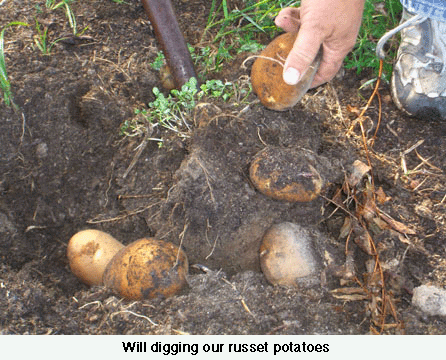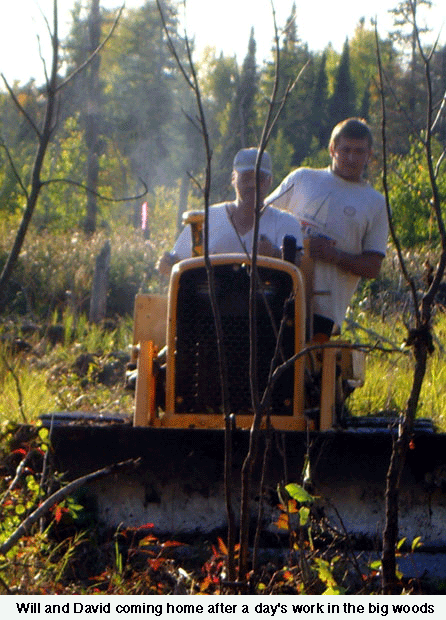We’ve dug our second row of five rows of potatoes, yielding 50 pounds of big fat russet potatoes. Watching those nice clean potatoes roll away from the shovel was just like Christmas morning for Will and I. I had been afraid they might be scabby because of all the rotted manure I’d dumped on that area last fall. But not a trace! And the potatoes are just great.
We got 100 pounds of red potatoes, leaving us with our Yukon Gold, assorted fingerlings and David’s All Blue potatoes yet to dig. David loves his blue potatoes (that really are more purple than blue….even when made into mashed potatoes. Yes, they’re weird, but he likes to grow them every year and this year they are even bigger than before. Yea! We love the manure, don’t we?
While we’re still harvesting (I picked thirty pounds of big fat red tomatoes today.), we are starting to work on developing new trails in our big woods so we can access firewood and make fences around it for some more horse pasture in the clearings. When David’s home, he and Will grab the chainsaw, chains and the good old dozer and head for the woods. They’re having lots of guy fun out there and it’s amazing how much firewood they’ve already hauled in! We had a lot of blow-down trees that are still good, but won’t be much longer if they aren’t cut up. And we sure hate to waste anything around here. Especially when it keeps us warm in the winter.
Readers’ Questions:
Old pressure canner
I have a pressure canner with the weight type pressure regulator. It is old, from the 70’s, but has new sealing ring and rubber on the automatic air vent. I think I have been cooking at too high heat (gas stove), as my corn from last year tasted scorched. I use 15 lbs for our altitude. My instruction book says to start timing when the pressure regulator begins to rock gently, and then to adjust the heat to maintain a slow steady rocking motion. I have always been in a hurry to adjust the heat when the regulator slowed down to barely a wobble. I decided to experiment and leave the flame alone. I was canning stuffed peppers (inspired by you). The regulator slowed down, and movement was barely noticeable, but I could see SOME movement, sometimes the regulator just turned and barely moved back & forth. However, there were small bursts of steam that continued, which I could hear. Then it picked back up a little, and rocked a little more noticeably. The time when it was turning and barely noticeably moving wasn’t for long, maybe 20 seconds. It makes me nervous that it may have been too slow. Can you explain to me what they mean by “gentle rocking”? I was always told you have to start re-timing if it stops. I know you cook with a dial gauge, but am hoping you can reassure me, or tell me to throw out the food! I will keep trying anyhow. Thanks for your help!
Robin Huber
Coudersport, Pennsylvania
The weight doesn’t need to jiggle constantly, but it does rock to release steam to maintain an equal pressure in the canner. If the heat is too high, it will rock noisily and faster. If it is too low, it won’t rock much at all, nor will steam be released. Most instructions call for the weight to rock about 3-4 times a minute, at least. With more experience, you’ll learn to “read” your canner’s noises. — Jackie
Threshing buckwheat
I recently read your article in the Sept/Oct issue on growing your own grains, and then I shared it with my dad. He just started experimenting with grains in his gardens (yes plural) in the last few years, and has done pretty well. But he has hit a snag and asked me to pass his question on to you.
Last year he grew wheat and buckwheat. His wheat threshed out nicely and cleaned easily, but his buckwheat did not. Do you have any tips on “de-hulling” or threshing buckwheat to prepare for grinding to flour? He was wondering if he could just coarsely grind it to break up the hulls and then winnow it from there. What do you think?
Janelle Martinez
North Highlands, California
This is a problem with homesteaders. I simply grind up hull and all, figuring it’s fiber. But the only way you can remove the hulls is with expensive machinery. If SOMEONE knows a way, please let us all know, okay? Thanks! — Jackie
Canning bacon
In Issue 93 a reader asked if bacon can be canned. You wrote that you have canned it, but you did not explain how to do it. Could you please tell me how it’s done? With the world disintegrating, I’m very worried about using my freezer as much as I do. I can’t afford to discard meat since it’s so costly. Can you help me? I have used a pressure canner for years, so I know how to do it.
Beverly Robbins
Tallmadge, Ohio
You can home can bacon, just like you can any other meat. I’ve had the best luck, by far, by canning my own home raised bacon. Number one, it’s leaner, and number two, it’s in a dryer form, being in an uncut side of bacon, than store bacon, which is greasy and sliced thinly. To can a side of bacon, simply cut it into chunks that will fit into a wide mouth canning jar, within an inch of the top. You can slice it, thickly, keeping it in the shape it was in. Canning store bought bacon is a little more difficult, in that it doesn’t keep a pretty appearance as well. But you can do it.
To can bacon, pack it into your wide mouth jars (pints work best), then place the open jars into a roasting pan, filled to about 2″ of the top of the jars, with boiling water. Place this on your stove and simmer until a thermometer inserted into the center of one of your center jars reads 170 degrees. Then adjust your lids and process without liquid added for 75 minutes for pints or 90 minutes for quarts. Be especially careful to wipe your jar rims with a damp clean cloth as bacon can be greasy and the grease on the rims can prevent the lids from sealing. — Jackie





Anne M,
Again, I’m real sorry I was unclear. You process your jars in a pressure canner, not the roasting pan!
Jackie
Kathleen,
Oops! All meat must be pressure canned; I screwed up with my directions. Sorry. Process it at 10 pounds pressure unless you live at an altitude above 1,000 feet. Then consult your canning manual for directions on increasing your pressure to suit your altitude, if necessary.
Jackie
Jackie,
In the instructions for canning the bacon, did you mean for it to processed in the pressure canner?
Jackie,
I don’t understand. You said above —
“…Then adjust your lids and process without liquid added for 75 minutes for pints…”
do you mean process in a pressure canner or still in the roasting pan?
thanks for the great recipes!
Hi Jackie,
I have found a way to can some of those extra summer squash. I had read about roasting the tomatoes before canning so I thought I would make a vegie sauce. It came out fabulous! I don’t cook with recipies, but I’ll give you an idea. 8 carrots julienned, 10 squash chopped medium, 1 head garlic chopped medium, 2 large onions. I put them in a giant roasting pan in the oven at 325. I then roast eggplant and a few poblanos peel chop and add to the mixture. I then start chopping my tomatoes into eights for small ones or twelfth for large ones. I drop the temp to 300 and add the tomatoes as I fill my bowl up. I kept doing this adding a little salt and italian seasoning each layer till the pan was full. I cooked it down to my liking added a little wine and canned away. WOW what a yummy sauce
Comments are closed.